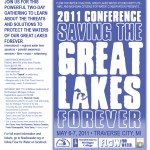RIO TINTO’s bad investment in a nickel mine, but Michiganders have the most to loose if the Eagle Mine is built.
Bloomberg News Jun 13, 2011 – 9:43 AM ET
By Agnieszka Troszkiewicz and Maria Kolesnikova
At a time of scarcity in everything from crude oil to copper to corn, nickel is heading for the biggest glut in four years, driving prices lower into 2012.
Next year’s surplus will rise to 60,000 metric tonnes from 12,000 tonnes in 2011, making nickel the most oversupplied metal relative to output or use, according to Bank of America Merrill Lynch, the most-accurate forecaster tracked by Bloomberg over two years. New mines will boost supply 11% in 2012, the most in 17 years, Macquarie Group Ltd. says. Prices may drop 12% to US$20,000 a ton by Dec. 31, the median estimate in a Bloomberg survey of 17 analysts and traders shows.
“I’m not particularly optimistic about nickel,” said Ian Henderson, who manages about US$10 billion of natural-resource assets at JPMorgan Chase & Co. in London, including the Global Natural Resources Fund, which doubled in two years. “I don’t think there is a commercial logic for the price where it is today. A nickel price of US$15,000 is entirely possible.”
While raw-material producers are failing to extract enough copper and oil and droughts threaten crops, nickel supply is expanding faster than demand. Prices reached a record US$51,800 in 2007 and moved at least 63% a year since then, leading consumers to use more substitutes than in any other major commodity, Macquarie says. Ikea Group, the world’s largest home- furnishings retailer, is removing the metal from kitchen and bathroom products.
Used mostly in stainless steel, nickel fell 8.5% to US$22,648 this year by 6:56 a.m. on the London Metal Exchange, making it the third-worst performer after raw sugar and zinc on the Standard & Poor’s GSCI index of 24 commodities, which advanced 11%. The MSCI All-Country World Index of equities is little changed and Treasuries returned 3.1%, a Bank of America Merrill Lynch index shows.
Construction and transport account for 37% of nickel demand, with another 18% used in machinery and electrical applications, according to UBS AG. Consumption of 1.51 million tons in 2010 was worth US$33 billion at last year’s average price.
Declining prices mean profit at OAO GMK Norilsk Nickel, the world’s biggest producer, will probably be little changed this year, Chief Executive Officer Vladimir Strzhalkovsky said in an interview June 8. Nickel accounted for about 43% of the Moscow-based company’s 2009 sales.
“If there is a glitch in the global economy, demand for industrial metals will go down,” he said. “It’s dangerous to depend on nickel.”
Winning Streak
The bear market ends a two-year winning streak when prices more than doubled. As demand rebounded from the worst global recession since World War II, supply was curbed by strikes of a year or more at Vale SA’s Sudbury and Voisey’s Bay mines in Canada. The disputes have ended and the Rio De Janeiro-based company predicts a 56% production gain this year.
Lower prices may force higher-cost smelters to curb or halt output, limiting declines. China is the world’s biggest nickel producer. The nation’s least-efficient makers of nickel pig iron, a cheaper alternative to refined nickel, need about US$20,000 a ton to break even, according to Societe Generale SA. Reduced demand from stainless steelmakers and rising energy costs make it more likely that privately owned smelters will shut in the second half of 2011, the bank said in a report.
Chinese imports of nickel ore rose 29% in March from a year earlier and 33% in April, spurring analysts to anticipate a similar increase in the country’s production. Those assumptions could be wrong because the ore may be of a lower grade, reducing the amount of metal that can be extracted and curbing the pace of production growth, Societe Generale said in a report June 3.
Mining costs are surging. The cost of everything from wages to energy to changes in exchange rates rose a combined 25% in Canada, 18% in Australia and 12% in Russia last year, according to UBS.
Prices were partly supported this year by a 17% decline in stockpiles monitored by the LME. With Barclays Capital predicting that the market will move into a supply surplus in the third quarter, that trend in inventory may reverse.
The surplus in aluminum will narrow to 301,000 tons this year, from 609,000 tons in 2010, Bank of America Merrill Lynch estimates. Prices for the metal used in aircraft and cars rose 6% this year on the LME. The glut in zinc will drop to 11,000 tons from 675,000 tons, the bank forecasts. Zinc retreated 8.1% in London since the start of January.
Production of copper will fall 380,000 tons short of demand in 2011, compared with a 108,000-ton deficit in 2010, Bank of America Merrill Lynch says. Prices declined 6.9% this year. Lead, which declined 0.2% since Dec. 31, is moving into a shortfall of 61,000 tons from a surplus of 35,000 tons, the bank predicts. Supply of tin, which fell 5.8% this year, will be 12,000 tons less than demand, the same amount as in 2012, Barclays Capital estimates.
The oil market is using inventory and the spare production capacity of the Organization of Petroleum Exporting Countries to meet consumption, Goldman Sachs Group Inc. said in a report May 23. Both will eventually become exhausted, requiring higher prices to restrain demand, the bank said. New York-traded crude oil rose 8.7% this year.
In agriculture, Rabobank International expects supply deficits in corn, soybeans, wheat, coffee, cotton and cocoa in the 2010-2011 or 2011-12 seasons. The Standard & Poor’s GSCI Agriculture Index of eight commodities jumped 73% in the past 12 months.
Nickel supplies are increasing at a time when economic growth is showing signs of weakening. U.S. Federal Reserve Chairman Ben S. Bernanke said June 7 the recovery remains “uneven” and “frustratingly slow,” three days after the Labor Department reported that employers added the fewest jobs in eight months.
German industrial production fell for the first time in four months in April, the Economy Ministry said June 8. A day earlier, the World Bank cut its 2011 global growth estimate to 3.2% from 3.3%.
While stainless-steel output rose 8.6% to 8.39 million tons in the first quarter, a record for the period, the International Stainless Steel Forum said last month that gains won’t be sustained through the year. The Brussels-based group’s members account for about 75% of global output. Rising production may also mask a swing toward demand for steels containing less nickel or substitution with other materials.
Ikea, based in Stockholm, plans to almost eliminate nickel from its bathroom and kitchen products by August 2012, said Gaetano Ronchi, a senior manager at the company’s purchasing arm. Of the 80,000 tons of stainless steel it uses annually, 88% is now nickel-free, he said.
With nickel accounting for at least half the cost of 300- series stainless steel, the most common type, the retailer is not alone in seeking alternatives. The steel’s market share fell to 56% last year from 72% in 2000, Macquarie estimates.
Nickel demand now is about 20% lower than it would have been if prices hadn’t jumped more than fourfold to the 2007 record in the space of 18 months, according to Jim Lennon, the head of commodities research at Macquarie in London who has been following the market for three decades.
The switch from nickel-bearing stainless steels means less potential to absorb additional supply. Vale will start the furnace at its Copper Cliff plant in Sudbury in June after four months of repairs. Xstrata Plc, based in Zug, Switzerland, reopened its Falcondo plant in the Dominican Republic in the first quarter, having shut it in 2008.
Norilsk resumed production at its Lake Johnston mine in Australia last week, after halting operations in 2009 because of costs. While the company forecasts a 5.9% increase in output this year, it wants to decrease its reliance on nickel in favor of copper, iron ore and coal.
Pacific Metals Co., based in Tokyo, Japan’s largest ferronickel producer, plans to open its Hachinohe plant in June after repairing damage caused by the country’s earthquake in March. Ferronickel contains about 38% nickel and is used by stainless-steel makers as a cheaper alternative to refined metal. New supply is also coming from projects in Brazil owned by Vale and London-based Anglo American Plc.
“Nickel probably has the most bearish outlook of all the metals,” said Michael Widmer, an analyst at Bank of America Merrill Lynch in London. “The thing that saved the market in the last two years was the strike at Vale. Someone will have to cut output, or delay projects.”
 WaterLegacy is collaborating with Friends of the Boundary Waters to promote Sulfide Mining Awareness Day on June 22.
WaterLegacy is collaborating with Friends of the Boundary Waters to promote Sulfide Mining Awareness Day on June 22. 


